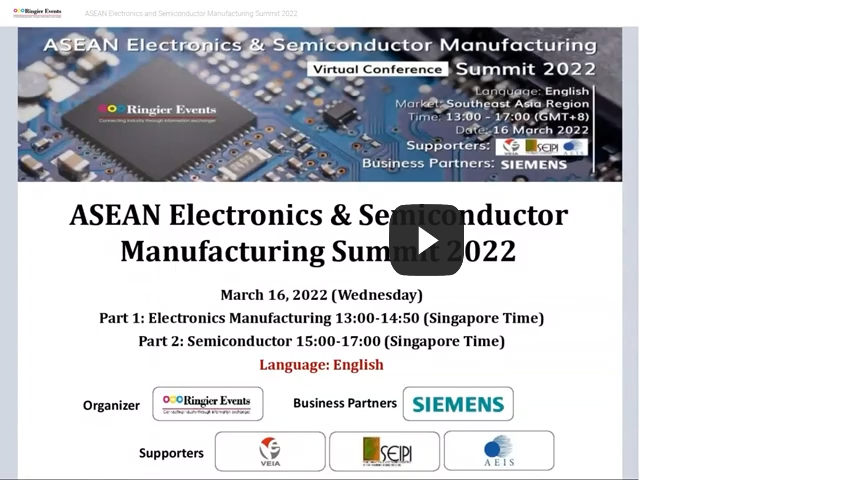Supply Chain Resilience in Electronics Manufacturing

How can electronic manufacturing companies develop resilient supply chains? Sherwin Nones, IMI’s Head of Strategic Planning and Marketing, discusses the factors shaping the business landscape and how manufacturers can seize opportunities and overcome hurdles.
During the ASEAN Electronics and Semiconductor Manufacturing Summit, Sherwin Nones, IMI’s Head of Strategic Planning and Marketing, was invited to discuss supply chain disruption in the electronics industry.
Read on to discover the challenges and opportunities affecting the electronics manufacturing industry–and what strategies companies should employ to weather future storms.
The state of play
After contracting in 2020 because of the COVID-19 pandemic, the global GDP rebounded to 5.9% in 2021. According to the January 2022 World Economic Update by the IMF, global GDP is expected to normalize at 4.4% this 2022.
In the ASEAN market, the PMI showed an expansion over the past months. This development was not only for electronics–which comprises 30-40% of the manufacturing industry in the region–but also for other manufacturing activities.
“Demand continues to rebound and it’s very strong, but there are inflationary pressures that remain and might affect us because of the war [in Ukraine],” said Nones.
From geopolitical conflicts to material shortages to growing markets, the electronics industry continues to face both challenges and opportunities.
“What used to happen gradually can now happen suddenly,” said Nones. “The new normal is not just about the pandemic, but the presence of disruptions that can happen suddenly.”
Geopolitical tensions and conflicts
“It usually takes decades for things to change. But we saw in the Russian-Ukraine conflict the [sudden] geopolitical alignments and shifts,” said Nones. “Even companies started to change their alignment and direction, which normally happens over a long period. This is a trend that is pointing to lots of disruption.”
Russia and Ukraine control two materials needed to make semiconductor chips: palladium and neon. Russia controls 44% of global palladium supplies, while Ukraine controls 70% of the world’s neon supply.
“These two resources are key to producing semiconductor chips necessary for almost all industries–from cars to phones to consumer electronics and even the medical industry,” Nones shared.
(Also read: From Automakers to Chip Makers: Will DIY Save the OEMs?)
“This conflict will feed into the increasingly inflationary environment most countries find themselves in--which, in turn, is likely to lead to central banks tightening, higher interest rates, and slower growth. The war in Ukraine will adversely impact companies and consumers with no direct links to the situation via higher prices and interest rates,” Nones continued.
Russia also supplies 40% of oil to Europe, and increasing oil prices will make manufacturing processes more expensive. While global players can shift supply and demand, the move will affect prices and other factors. “So it’s not as easy overnight to change all these things on the supply and demand side,” said Nones.
“I think in some countries here in Southeast Asia, we’re feeling the cost of higher cost and inflation, the weakening of purchasing power, and disruption in the supply chain. Possibly not right now, but the close of ports and trade routes and shortages of components and commodities in the electronics industry might worsen this year if the conflict continues.”
(Also read: The Virtual Battlefield: Tech and Ukraine)
The rising cost of logistics
The war in Ukraine is also causing delayed shipments and rising costs in ocean freight rates.
As of March 2, export dwell times for all European ports have increased by 25% since February 17. According to FourKites, a supply chain visibility platform, transshipment dwell times for European ports have increased by 43% over the same period.
“We anticipate more delays in deliveries of components, shipments, exportations, and importations,” said Nones. “Ocean freight rates are increasing twenty- to fortyfold.”
From globalization to regionalization
"Before, there was a rush to China, which is the manufacturing center of the world. But given all the disruptions, companies are looking at expanding and firming up their capabilities in their region or the region that they serve,” says Nones.
By moving manufacturing to Southeast Asia and serving the regional market, companies can minimize their exposure to unforeseen shocks while strengthening their own capabilities.
Potential in the EV market
On the bright side is the rising EV market.
“We do still have a lot of demand, and one of these is from the EV market. And this is a positive disruption enabling a lot of companies, even startups, to really see what they can contribute,” said Nones.
“In 2021, the growth has exceeded double at 108%. This year, it is expected that we will reach a market share of 12.5%. For every vehicle that is sold in the global market, at least one of them is an electric vehicle. And that’s a huge jump,” he continued.
Other markets also benefiting from the rising EV market are the EV ecosystem and industrial markets.
“And that is also some of the markets that we are looking at in IMI,” Nones shared. "[These are] battery management systems–the power modules or the environment around the battery and smart meters in the industrial and consumer space. EV charging stations are really rising because of the amount of EVs being sold. And of course, medical devices continue to grow even after the pandemic."
“There are a lot of pockets of growth and opportunities in the EV ecosystem and industrial markets, and these are the opportunities where demand is really growing [and] electronics manufacturing companies [can] look into," Nones said.
“There are a lot of pockets of growth and opportunities in the EV ecosystem and industrial markets. These are the opportunities where demand is really growing [and] electronics manufacturing companies [can] look into. Of course, part of this is really making sure that we have the technology and we possess the right people to be able to implement them.”
(Also read: Shifting Gears to EV: OEM’s Next Challenge)
Resiliency amidst supply chain disruption
“Disruptive elements that change market forces abruptly are the new normal,” said Nones. “It is something that needs to be accepted and known so we can mitigate these risks.” With this outlook in mind, Nones shares his recommendations for developing a resilient supply chain.
Supply chain management needs to be a core competence
“Something that used to be nice to have is now put front and center. We need to have the skills, workforce, and technology to be able to manage the supply chain in a more predictive manner. Not just reacting, but being able to analyze, use the technology, even AI to figure out the best solutions for the current problems that we have.”
Technology to predict outcomes
“Using predictive analytics will be a vehicle to cushion the negative market impacts, predict outcomes, and most importantly, create value.”
Design for disruption
“Design for disruption is a must. We need to design the hardware, the software, and the whole system in such a way that it can weather disruptions in all aspects. Whether it is in supply or the issue of labor, we need to become flexible but still be able to address the objectives that we had at the beginning.”
Collaboration and communication
“Companies, even competitors, along with suppliers and customers, need to collaborate to create more resilient trade environments. We need to collaborate not just to come up with new businesses and opportunities, but to make sure that the road towards ease of trade will be feasible and workable for all so that we can all create common value.”
As one of the Top 19 EMS companies in the world, IMI has over 40 years of experience in providing electronics manufacturing and technology solutions.
We are ready to support your business on a global scale.
Our proven technical expertise, worldwide reach, and vast experience in high-growth and emerging markets make us the ideal global manufacturing solutions partner.
Let's work together to build our future today.




